Numerical Investigation on the Hydraulic Properties of the Skimming Flow over Pooled Stepped Spillway
Abstract
1. Introduction
2. Numerical Simulation
2.1. Volume of Fluid Method
2.2. Turbulence Model
2.3. Boundary Conditions
- (a)
- Inflow boundary: Velocity of the flow calculated from the discharge, which is 0.113 m3/s in all cases, was given as the inlet boundary;
- (b)
- Outflow boundary: Pressure outlet boundary was selected at the outlet and there was no normal gradient for all variables;
- (c)
- Free surface: Pressure inlet was employed and its value was the standard atmospheric pressure; and
- (d)
- Wall boundary: No-slip velocity boundary and wall function were chosen for the wall surfaces and near-wall regions, respectively.
2.4. Grid Testing and Model Verification
3. Results and Analysis
3.1. Flow Pattern
3.2. Velocity Distribution
3.3. Pressure Distribution
3.4. Residual Head and Energy Dissipation
4. Conclusions
- The flow pattern in FP-FP presented no significant change in the transverse direction and was similar on different steps. But changing half of the fully pooled steps into partially pooled steps (two-sided pooled or central pooled) can result in three dimensional flow motion. In FP-TP, the maximum vortex intensity on the fully pooled steps and partially pooled steps occurred at the axial plane and sidewalls, respectively, while the opposite phenomenon can be seen in FP-CP. When replacing all the fully pooled steps by staggered configuration of two-sided pooled and central pooled steps (TP-CP), the flow was characterized by highly three dimensional motion, and the vortex development in the transverse direction showed a unique pattern with the maximum intensity of vortex occurring at Z/W = 0.25. Besides, TP-CP created more flow instabilities and turbulent structures.
- The velocity distributions over the steps in FP-FP highlighted the similar pattern with the minimum and maximum values occurring at y/ymax = 0.3 and 0.9, respectively. In FP-TP, FP-CP and TP-CP, the velocity distributions on the odd-number steps was different from that of the even-number steps, but the maximum velocity in all configurations indicated no difference. In the transverse direction, the velocity distribution in FP-FP showed the smallest variation, while TP-CP presented the greatest change.
- The pressure on the horizontal step surfaces of FP-FP, FP-TP and FP-CP showed U-shaped variations with the maximum pressures occurring at the downstream end of the step surface, and TP-CP highlighted the greatest pressure fluctuation in both streamwise and transverse direction. The pressure distribution patterns on the fully pooled steps in FP-TP and on the central pooled steps in FP-CP were similar; the pressure distributions on the two-sided pooled steps in FP-TP and on the fully pooled steps in FP-CP demonstrated the similar patterns. For the vertical steps, the maximum pressures on odd-number step surfaces were in the following order: FP-CP > TP-CP > FP-TP > FP-FP, while for the even-number steps, it was TP-CP > FP-FP > FP-TP > FP-CP. There was no negative pressure on the step surfaces.
- From the largest to the smallest, the energy dissipation rates were in the following order: TP-CP > FP-CP > FP-TP > FP-FP. Specifically, the energy loss for FP-TP and FP-CP was quite close, but slightly higher than FP-FP, and the energy dissipation rate for TP-CP was 1.5 times larger than FP-FP. Thus, changing half of the fully pooled steps into central pooled or two-sided pooled steps presented no obvious effect on the energy dissipation ratio, while shifting all the fully pooled steps into the combination of central pooled and two-sided pooled steps can significantly improve the energy dissipation performance.
Author Contributions
Funding
Conflicts of Interest
References
- Boes, R.M.; Hager, W.H. Hydraulic design of stepped spillways. J. Hydraul. Eng. 2002, 129, 671–679. [Google Scholar] [CrossRef]
- Chanson, H. Hydraulic Design of stepped spillways and downstream energy dissipators. Dam Eng. 2001, 11, 205–242. [Google Scholar]
- Chanson, H.; Luke, T. Hydraulics of stepped chutes: The transition flow. J. Hydraul. Res. 2004, 42, 43–54. [Google Scholar] [CrossRef]
- Chanson, H.; Toombes, L. Experimental investigations of air entrainment in transition and skimming flows down a stepped chute. Can. J. Civ. Eng. 2002, 29, 145–156. [Google Scholar] [CrossRef]
- Felder, S.; Chanson, H. Turbulence, dynamic similarity and scale effects in high-velocity free-surface flows above a stepped chute. Exp. Fluids 2009, 47, 1–18. [Google Scholar] [CrossRef]
- Wang, J.; Fu, L.; Xu, H.; Jin, Y. Numerical study on flow over stepped spillway using Lagrangian method. In Proceedings of the International Conference on Energy Engineering and Environmental Protection, Sanya, China, 20–22 November 2017. [Google Scholar]
- Felder, S. Air-Water Flow Properties on Stepped Spillways for Embankment Dams: Aeration, Energy Dissipation and Turbulence on Uniform, Non-Uniform and Pooled Stepped Chutes. Ph.D. Thesis, University of Queensland, Brisbane, Australia, 2013. [Google Scholar]
- Felder, S.; Chanson, H. Energy dissipation down a stepped spillway with non-uniform step heights. J. Hydraul. Eng. 2011, 137, 1543–1548. [Google Scholar] [CrossRef]
- Felder, S.; Chanson, H. Aeration, flow instabilities, and residual energy on pooled stepped spillways of embankment dams. J. Irrig. Drain. Eng. 2013, 139, 880–887. [Google Scholar] [CrossRef]
- Zhang, J.M.; Chen, J.G.; Wang, Y.R. Experimental study on time-averaged pressures in stepped spillway. J. Hydraul. Res. 2012, 50, 236–240. [Google Scholar] [CrossRef]
- Zhang, G.; Chanson, H. Effects of step and cavity shapes on aeration and energy dissipation performances of stepped chutes. J. Hydraul. Eng. 2018, 144, 04018060. [Google Scholar] [CrossRef]
- Peng, Y.; Zhou, J.G.; Burrows, R. Modelling the free surface flow in rectangular shallow basins by lattice Boltzmann method. J. Hydraul. Eng. 2011, 137, 1680–1685. [Google Scholar] [CrossRef]
- Peng, Y.; Zhou, J.G.; Burrows, R. Modelling solute transport in shallow water with the lattice Boltzmann method. Comput. Fluids 2011, 50, 181–188. [Google Scholar] [CrossRef]
- Peng, Y.; Mao, Y.F.; Wang, B.; Xie, B. Study on C-S and P-R EOS in pseudo-potential lattice Boltzmann model for two-phase flows. Int. J. Mod. Phys. C 2017, 28, 1750120. [Google Scholar] [CrossRef]
- Peng, Y.; Wang, B.; Mao, Y.F. Study on force schemes in pseudopotential lattice Boltzmann model for two-phase flows. Math. Probl. Eng. 2018, 6496379. [Google Scholar] [CrossRef]
- Baylar, A.; Unsal, M.; Ozkan, F. The effect of flow patterns and energy dissipation over stepped chutes on aeration efficiency. KSCE J. Civ. Eng. 2011, 15, 1329–1334. [Google Scholar] [CrossRef]
- Dong; Zhi-yong; Joseph; Hun-wei. Numerical simulation of skimming flow over mild stepped channel. J. Hydrodyn. 2006, 18, 367–371. [Google Scholar] [CrossRef]
- Zhenwei, M.U.; Zhang, Z.; Zhao, T. Numerical simulation of 3-D flow field of spillway based on VOF method. Procedia Eng. 2012, 28, 808–812. [Google Scholar] [CrossRef]
- Tabbara, M.; Chatila, J.; Awwad, R. Computational simulation of flow over stepped spillways. Comput. Struct. 2005, 83, 2215–2224. [Google Scholar] [CrossRef]
- André, S. High Velocity Aerated Flows on Stepped Chutes with Macro-Roughness Elements. Ph.D. Thesis, EPFL, Lausanne, Switzerland, 2004. [Google Scholar]
- Kökpinar, M.A. Flow over a stepped chute with and without macro-roughness elements. Can. J. Civ. Eng. 2004, 31, 880–891. [Google Scholar] [CrossRef]
- Thorwarth, J. Hydraulics of Pooled Stepped Spillways—Self-Induced Unsteady Flow and Energy Dissipation. Ph.D. Thesis, University of Aachen, Aachen, Germany, 2008. [Google Scholar]
- Hirt, C.W.; Nichols, B.D. Volume of fluid (VOF) method for the dynamics of free boundaries. J. Comput. Phys. 1981, 39, 201–225. [Google Scholar] [CrossRef]
- Li, X.; Wang, Y.R.; Zhang, J.M. Numerical simulation of an offset jet in bounded pool with deflection wall. Math. Probl. Eng. 2017, 2017, 1–11. [Google Scholar] [CrossRef]
- Zhang, J.M.; Chen, J.G.; Xu, W.L.; Wang, Y.R. Three-dimensional numerical simulation of aerated flows downstream sudden fall aerator expansion-in a tunnel. J. Hydrodyn. 2011, 23, 71–80. [Google Scholar] [CrossRef]
- Chen, Q.; Dai, G.; Liu, H. Volume of Fluid Model for Turbulence Numerical Simulation of Stepped Spillway Overflow. J. Hydraul. Eng. 2002, 128, 68–688. [Google Scholar] [CrossRef]
- Yakhot, V.; Orszag, S.A. Renormalization group analysis of turbulence. I. Basic theory. J. Sci. Comput. 1986, 1, 3–51. [Google Scholar] [CrossRef]
- Bai, Z.L.; Zhang, J.M. Comparison of different turbulence models for numerical simulation of pressure distribution in V-shaped stepped spillway. Math. Probl. Eng. 2017, 2017, 1–9. [Google Scholar] [CrossRef]
- Morovati, K.; Eghbalzadeh, A.; Javan, M. Numerical investigation of the configuration of the pools on the flow pattern passing over pooled stepped spillway in skimming flow regime. Acta Mech. 2015, 227, 1–14. [Google Scholar] [CrossRef]
- Carvalho, R.F.; Rui, M. Stepped spillway with hydraulic jumps: Application of a numerical model to a scale model of a conceptual prototype. J. Hydraul. Eng. 2014, 135, 615–619. [Google Scholar] [CrossRef]
- Celik, I.B.; Ghia, U.; Roache, P.J.; Freitas, C.J. Procedure of estimation and reporting of uncertainty due to discretization in CFD applications. J. Fluids Eng. 2008, 130, 078001–078004. [Google Scholar] [CrossRef]
- Felder, S.; Guenther, P.; Hubert, C. Air-Water Flow Properties and Energy Dissipation on Stepped Spillways: A Physical Study of Several Pooled Stepped Configurations; The University of Queensland: Brisbane, Australia, 2012; ISBN 9781742720555. [Google Scholar]
- Hunt, J.C.R.; Wray, A.A.; Moin, P. Eddies, streams and convergence zones in turbulent flows. In Proceedings of the Summer Program 1988; Stanford University: Stanford, CA, USA, 1988. [Google Scholar]

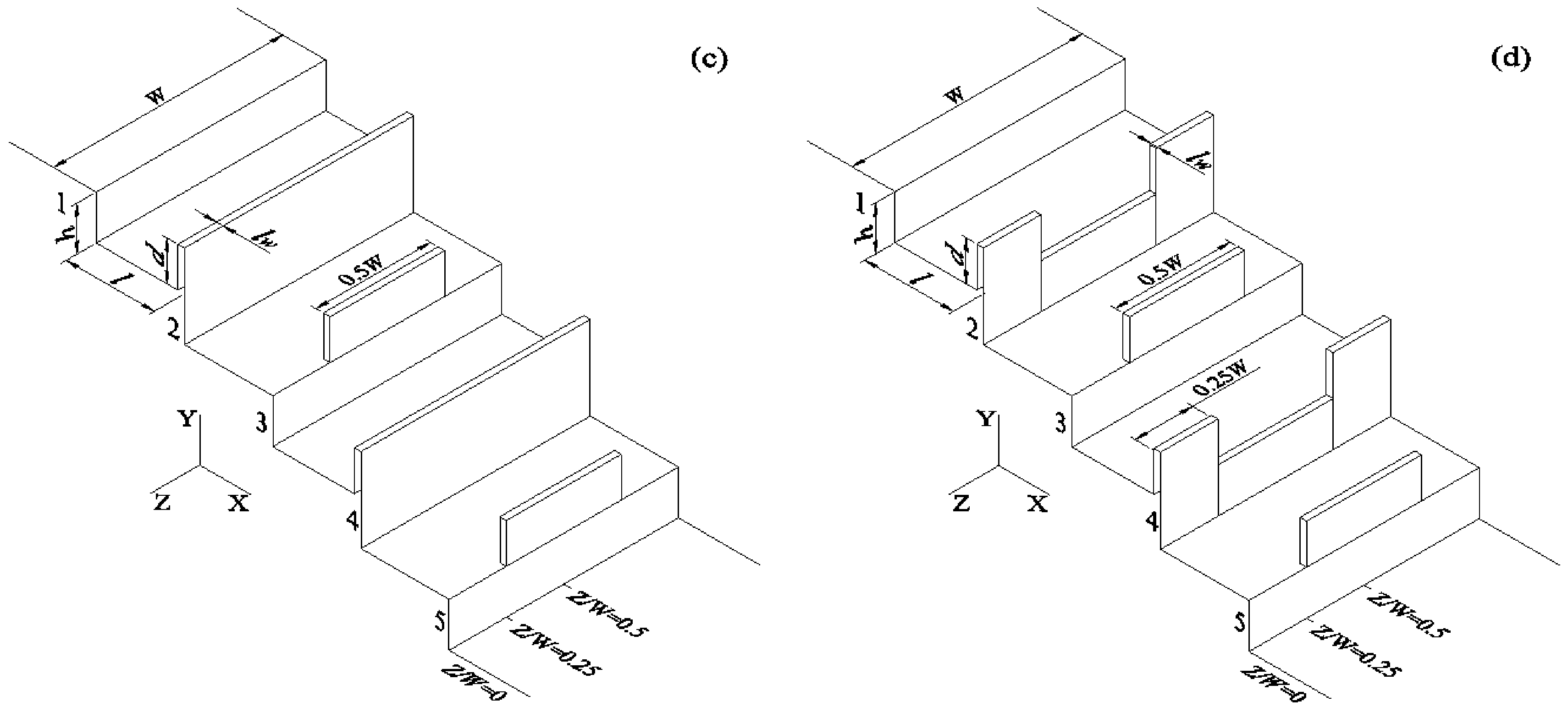


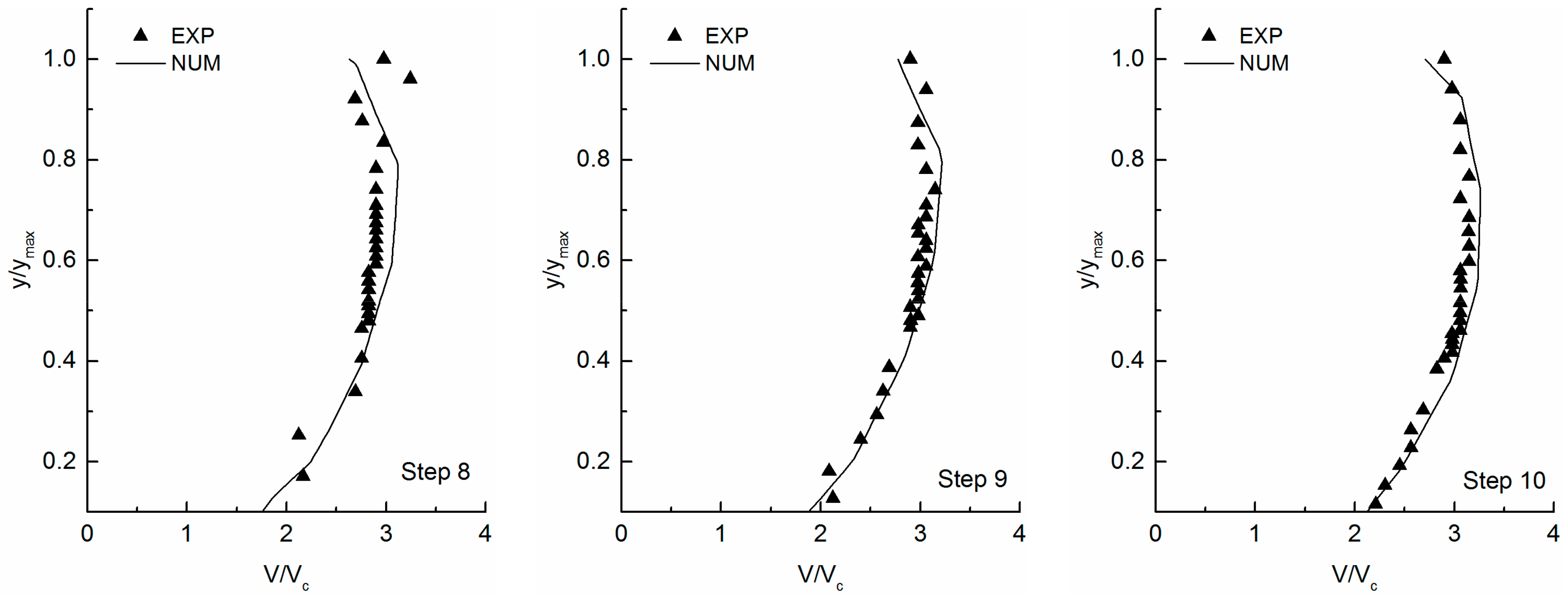
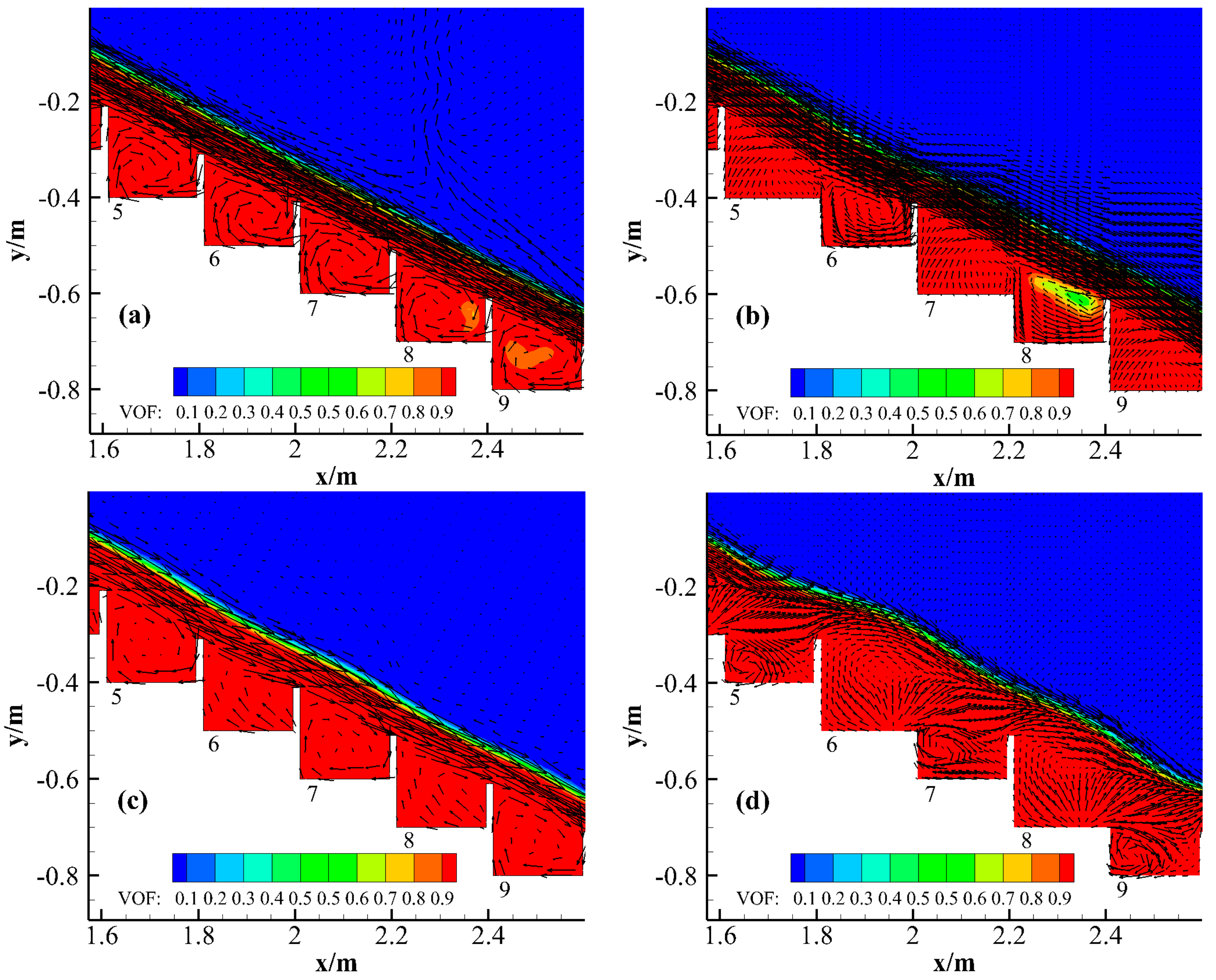

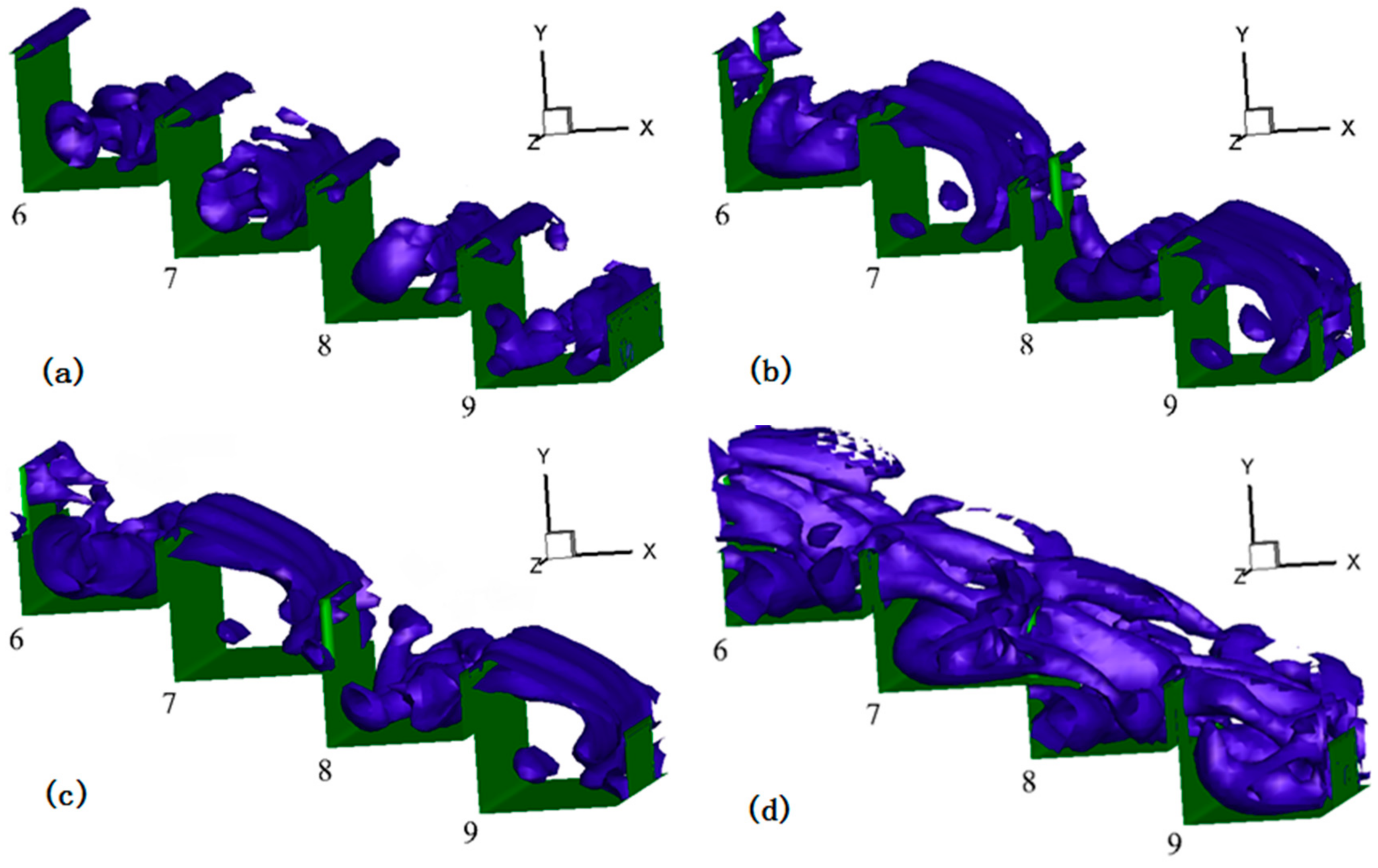

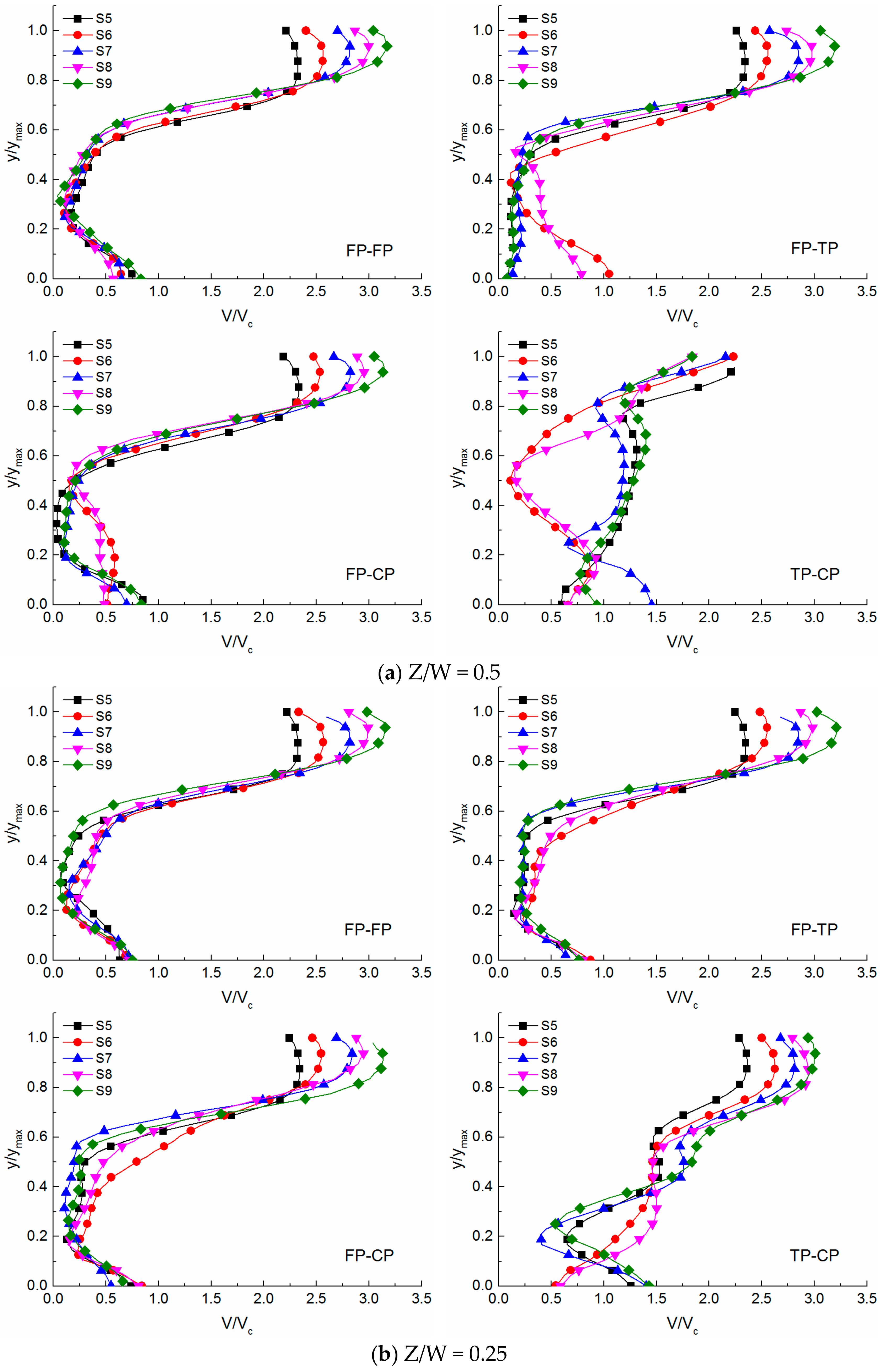
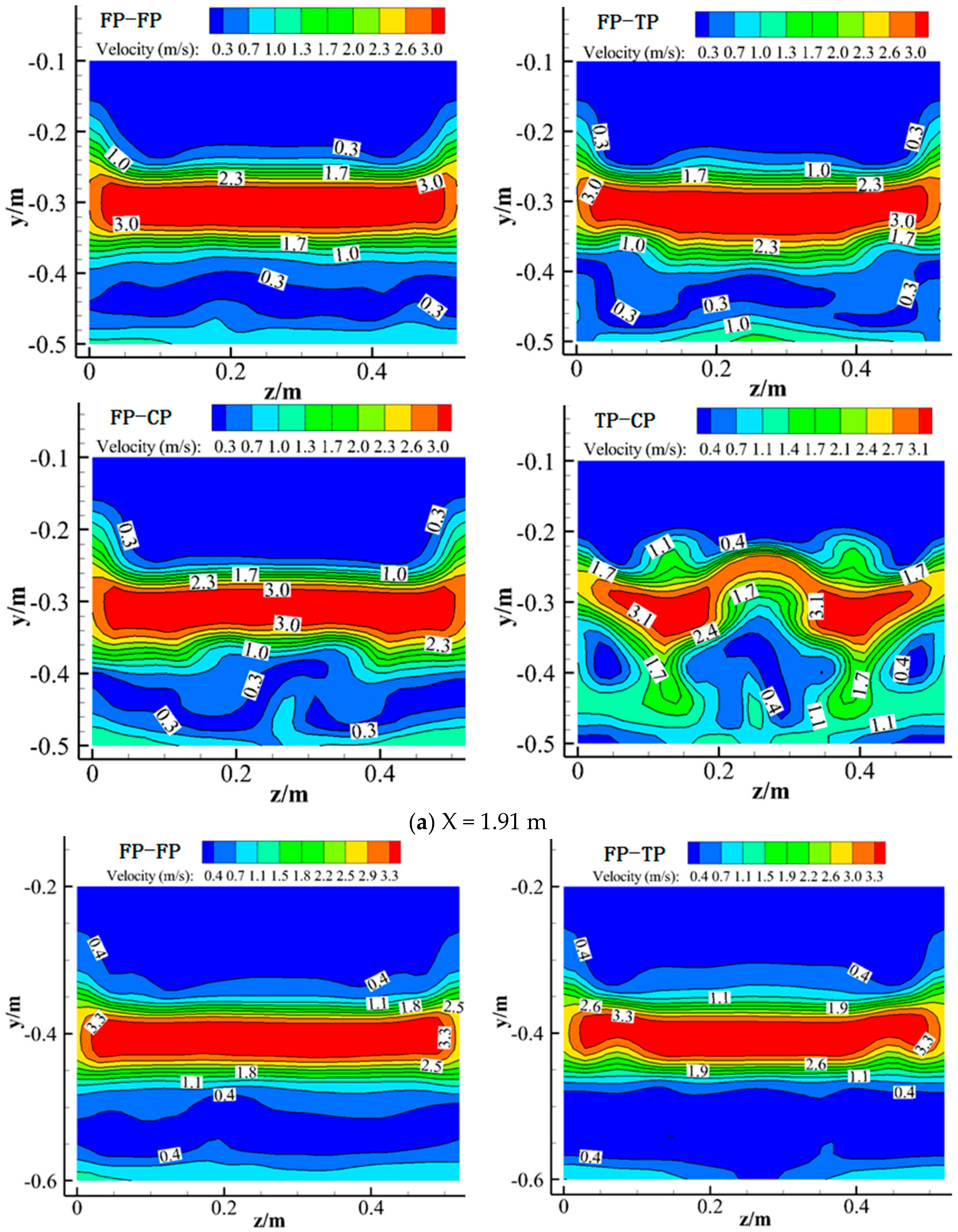
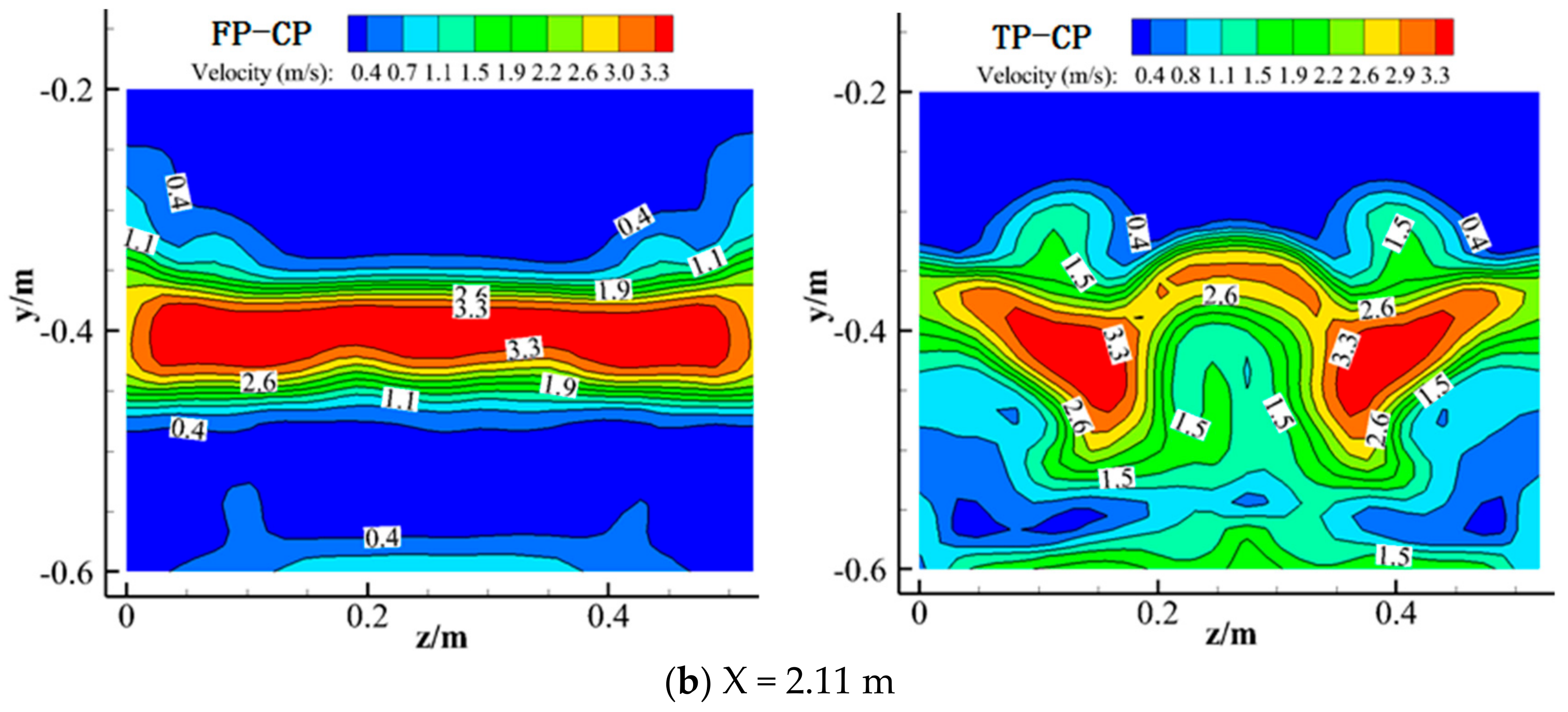
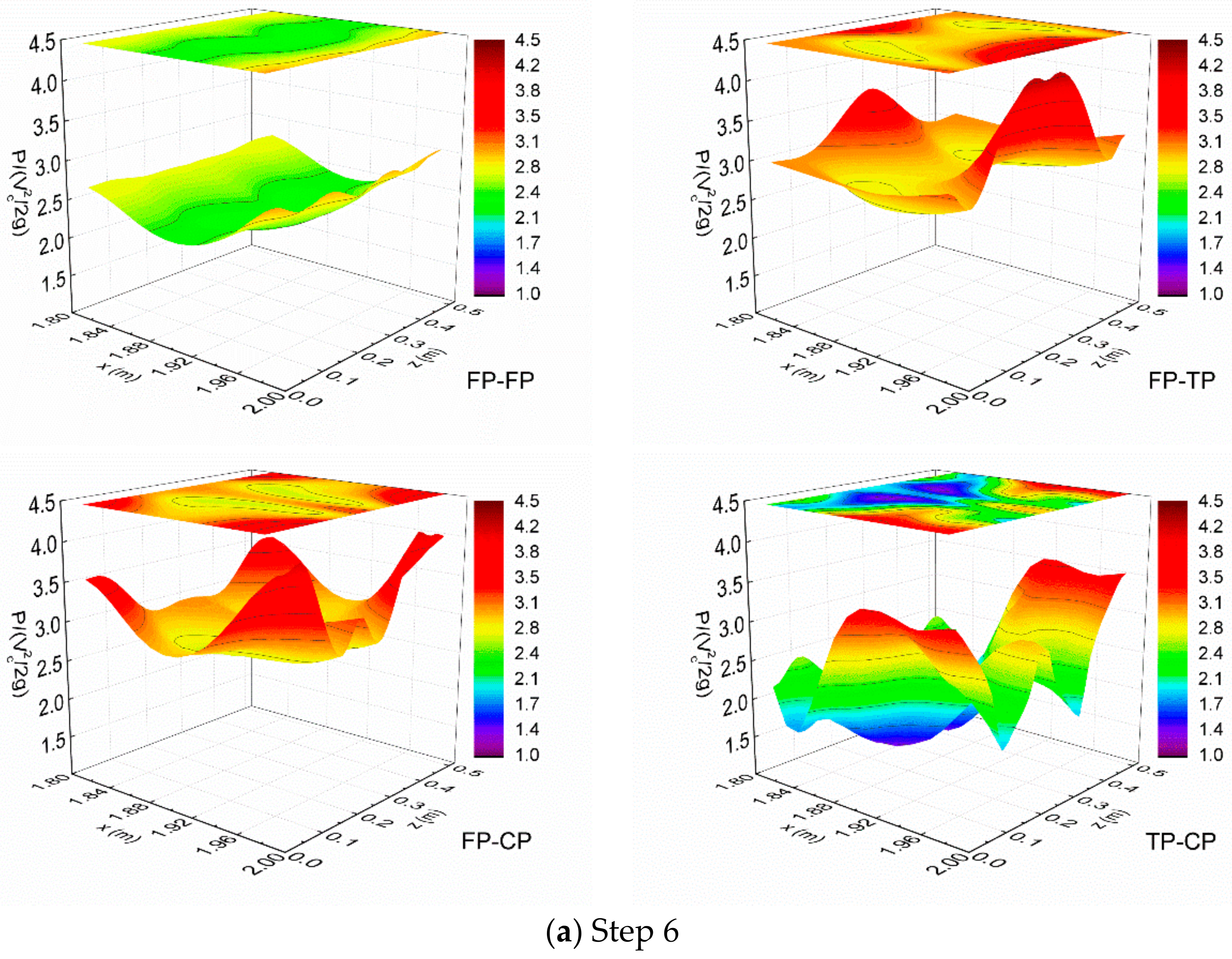

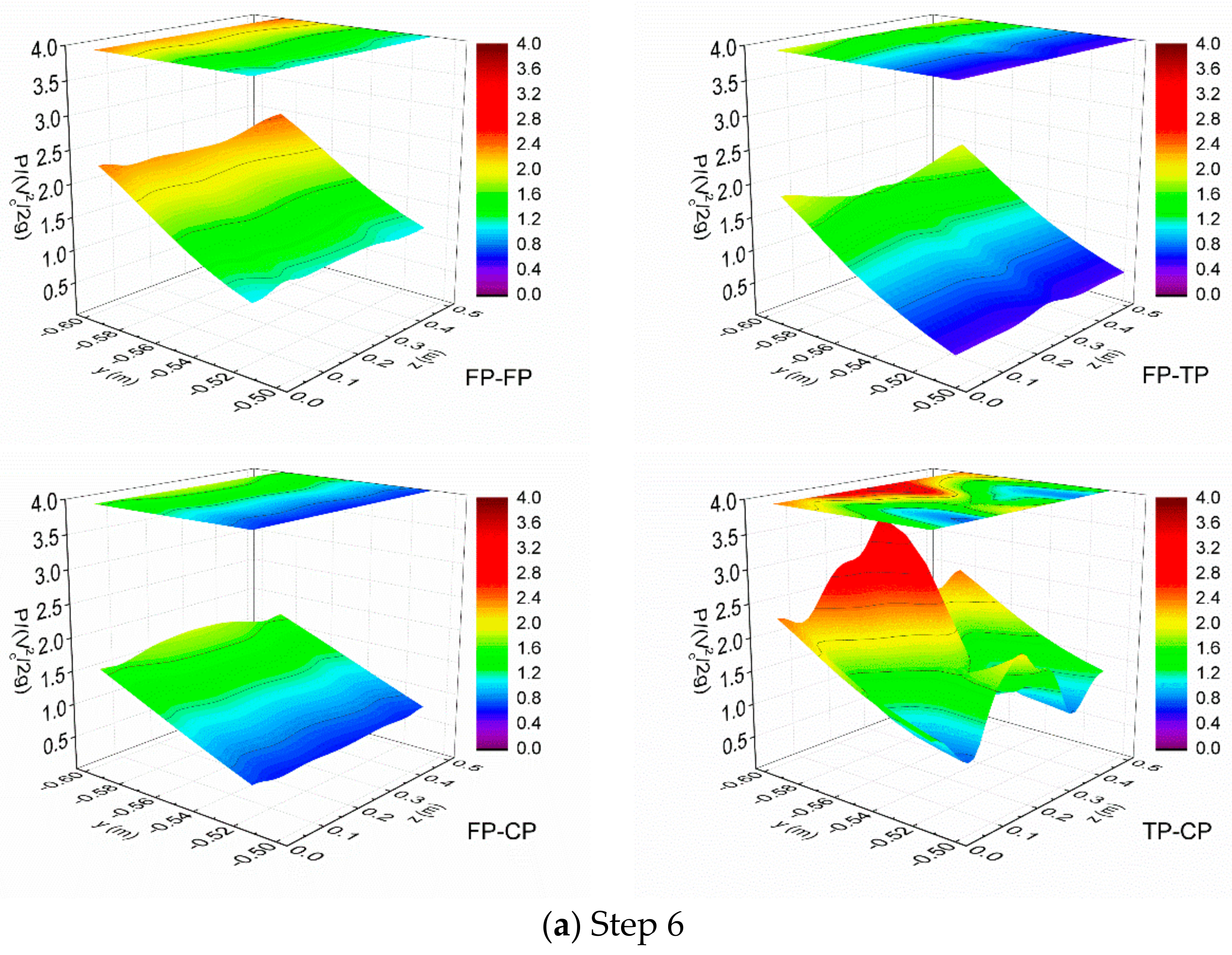
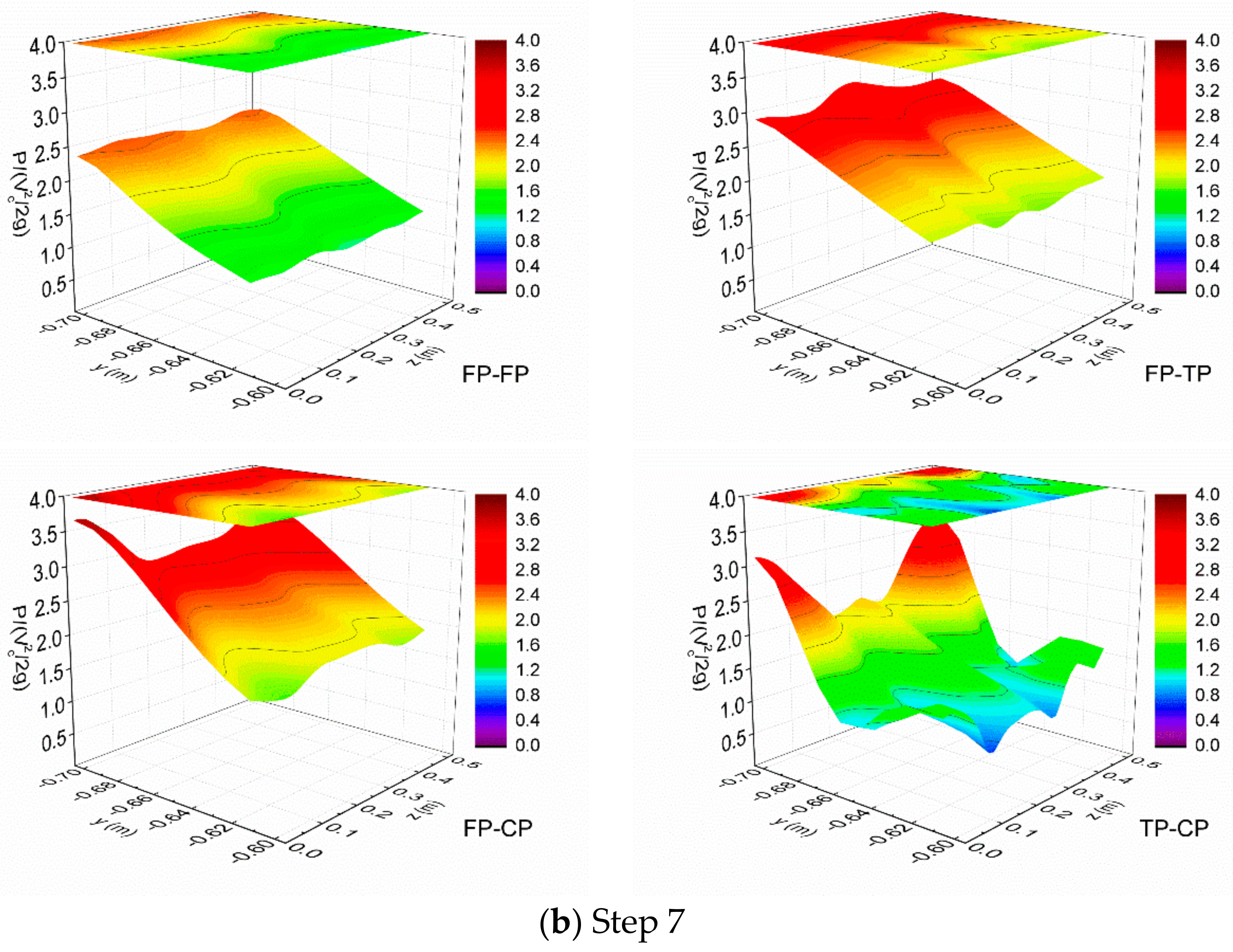
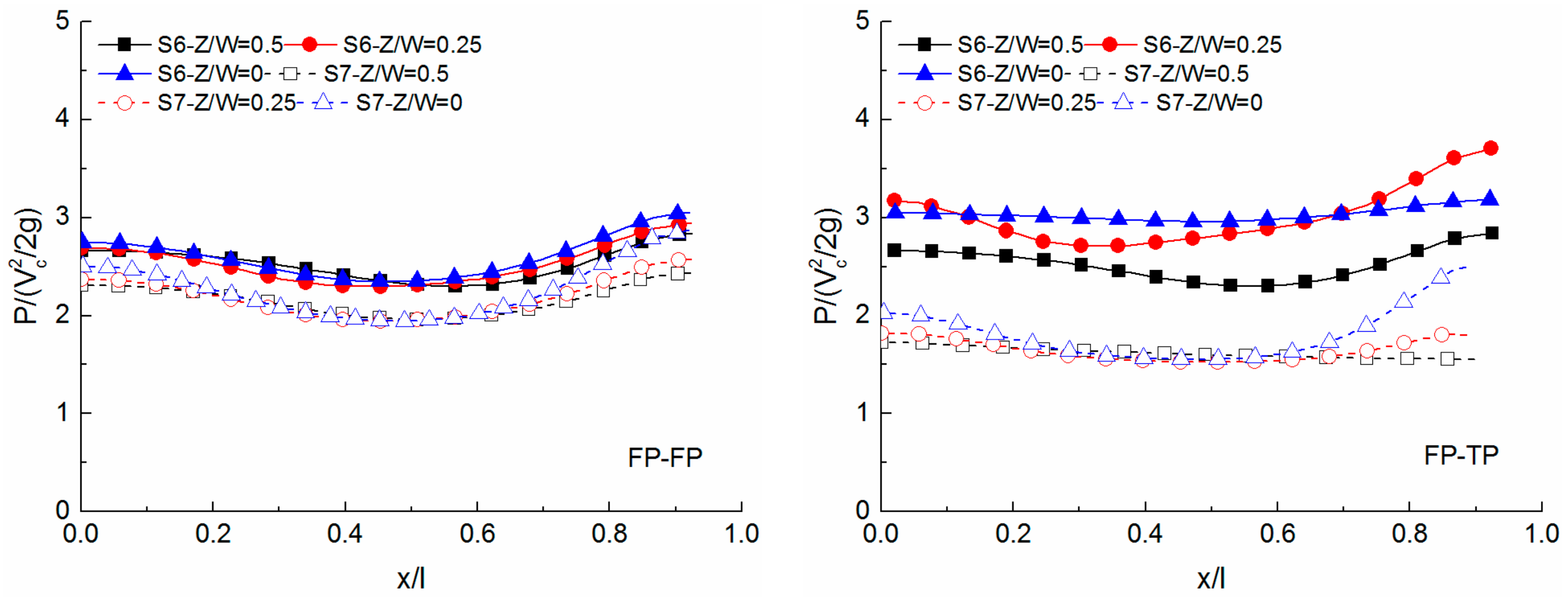
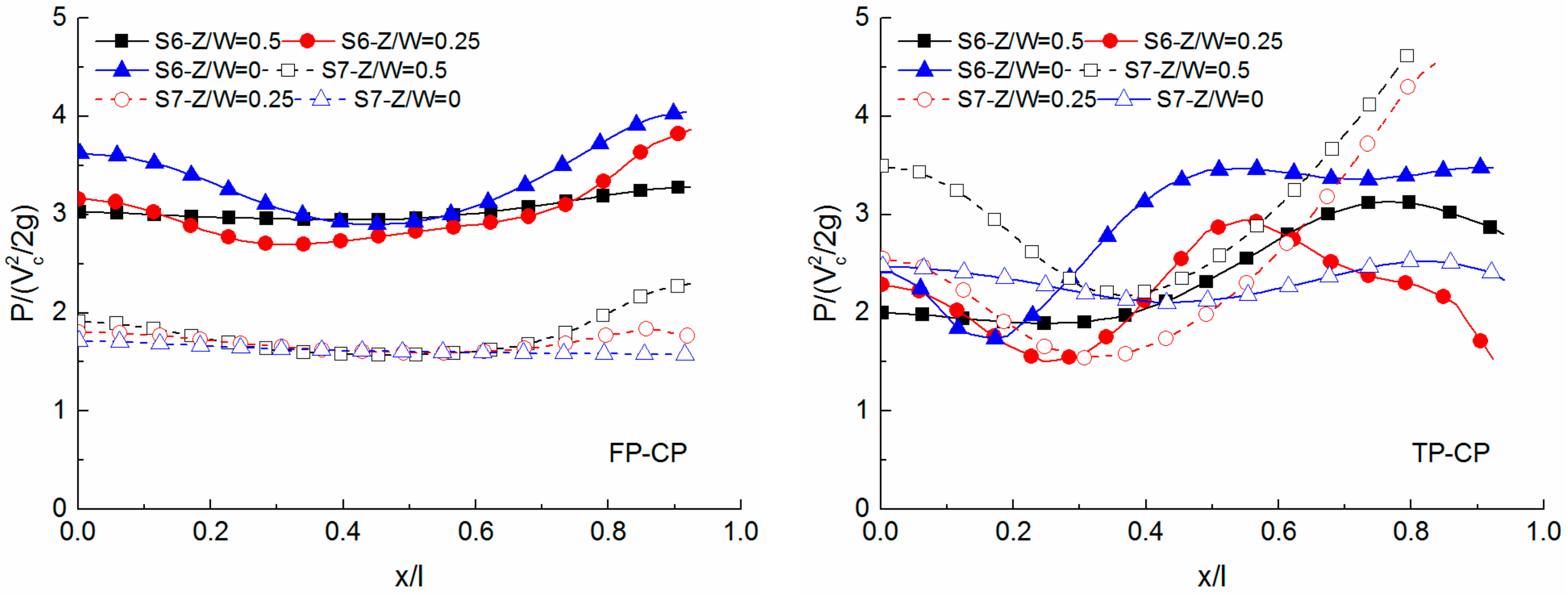


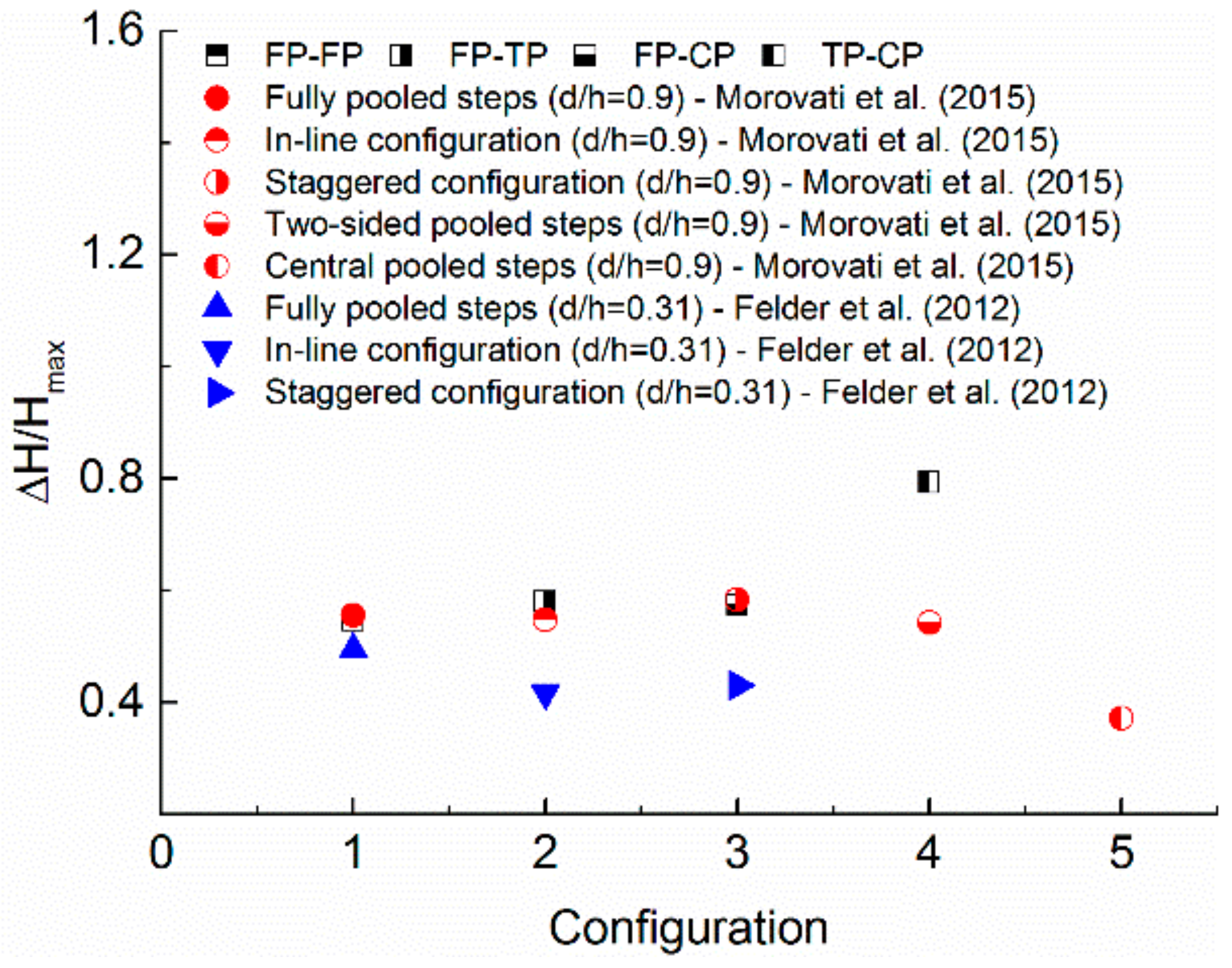
| 438 | |
| 0.012 | |
| 0.085 | |
| 1.68 | |
| 0.7179 | |
| 0.7179 |
| Reference | Step Geometry |
|---|---|
| Morovati et al. [29] | Fully pooled steps: h = 0.1 m, l = 0.2 m, d = 0.09 m |
| In-line configuration (pooled and flat steps in-line): h = 0.1 m, l = 0.2 m, d = 0.09 m | |
| Staggered configuration (pooled and flat steps staggered): h = 0.1 m, l = 0.2 m, d = 0.09 m | |
| Two-sided pooled steps: h = 0.1 m, l = 0.2 m, d = 0.09 m | |
| Central-pooled steps: h = 0.1 m, l = 0.2 m, d = 0.09 m | |
| Felder et al. [32] | Fully pooled steps: h = 0.1 m, l = 0.2 m, d = 0.031 m |
| In-line configuration (pooled and flat steps in-line): h = 0.1 m, l = 0.2 m, d = 0.031 m | |
| Staggered configuration (pooled and flat steps staggered): h = 0.1 m, l = 0.2 m, d = 0.031 m | |
| Present study | FP-FP: h = 0.1 m, l = 0.2 m, d = 0.09 m |
| FP-TP: h = 0.1 m, l = 0.2 m, d = 0.09 m | |
| FP-CP: h = 0.1 m, l = 0.2 m, d = 0.09 m | |
| TP-CP: h = 0.1 m, l = 0.2 m, d = 0.09 m |
© 2018 by the authors. Licensee MDPI, Basel, Switzerland. This article is an open access article distributed under the terms and conditions of the Creative Commons Attribution (CC BY) license (http://creativecommons.org/licenses/by/4.0/).
Share and Cite
Li, S.; Zhang, J. Numerical Investigation on the Hydraulic Properties of the Skimming Flow over Pooled Stepped Spillway. Water 2018, 10, 1478. https://doi.org/10.3390/w10101478
Li S, Zhang J. Numerical Investigation on the Hydraulic Properties of the Skimming Flow over Pooled Stepped Spillway. Water. 2018; 10(10):1478. https://doi.org/10.3390/w10101478
Chicago/Turabian StyleLi, Shicheng, and Jianmin Zhang. 2018. "Numerical Investigation on the Hydraulic Properties of the Skimming Flow over Pooled Stepped Spillway" Water 10, no. 10: 1478. https://doi.org/10.3390/w10101478
APA StyleLi, S., & Zhang, J. (2018). Numerical Investigation on the Hydraulic Properties of the Skimming Flow over Pooled Stepped Spillway. Water, 10(10), 1478. https://doi.org/10.3390/w10101478





